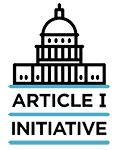Following the denial of certiorari in Paul v. United States, five Justices appear interested in revisiting the nondelegation doctrine and replacing the “intelligible principle” test with something else.[1] What remains to be seen is whether they can agree on what that something else should be.
In Gundy, three Justices endorsed a test with both objective and subjective components, such as whether the statute contained certain discretion-cabining features as well as whether Congress itself made all the relevant “policy judgments” rather than outsourcing that task.[2] Time will tell if a majority concurs. Even if it does, line-drawing may still prove to be difficult, as it has before.[3]
Not every case, however, is a hard case. While the Court searches for the line implicit within Article I, Section 1, separating constitutional delegations from unconstitutional ones, perhaps it could find consensus over an underinclusive bright-line rule in the meantime.
In his recent article in the Harvard Journal of Law & Public Policy, Professor David Schoenbrod proposes just such a rule.[4] He suggests the Court put out a “call” signaling it will begin to set aside certain regulations unless Congress first approves them.[5] The targeted regulations would be those that meet the definition of “significant” regulation the Executive Branch itself has used for the past several decades, particularly that part of the definition deeming a regulation “significant” if it has a predicted “annual effect on the economy of $100 million or more.”[6] If Congress does not respond to this call, the Court could then “[r]oll[] out the guillotine” and set aside such regulations.[7]
One might imaginably object that this rule is arbitrary. Fair enough. As Professor Schoenbrod observes, however, “the Court regularly adopts bright-line tests to make judicially manageable enforcement of norms that the Constitution states in amorphous terms.”[8] He has a point. Much of constitutional law consists of rules not compelled by the text but crafted by the Court as a way to implement and enforce the text. This process of creating implementing rules is not suspect so long as the rules created are consistent with the original meaning and function of the constitutional provision specifically and the Constitution generally.[9] As Professor Randy Barnett has observed, “[d]evising doctrine to effectuate what th[e] Constitution says does not violate a judge’s oath—it fulfills it.”[10]
Professors Steven Calabresi and Gary Lawson note that this “$100 million rule” would “surely be underinclusive rather than overinclusive of those actions that, as a matter of original meaning, violate” Article I, Section 1.[11] In other words, presuming they are right, the rule almost certainly would not ensnare any constitutional delegations. It would merely enforce to some measure what the Constitution mandates—that Congress address “important subjects” itself and delegate only detail-filling to agencies.[12]
Professor Schoenbrod has offered up an interesting idea. While the Court searches for a replacement for the “intelligible principle” test, this idea may prove useful as a step along the way.
All views expressed herein are solely those of the author.
[1] See Paul v. United States, 589 U.S. —, 140 S. Ct. 342 (2019) (mem.) (Kavanaugh, J., statement respecting the denial of certiorari); see also Gundy v. United States, 588 U.S. —, —, 139 S. Ct. 2116, 2131 (2019) (Alito, J., concurring in the judgment); id. at 2131-48 (Gorsuch, J., dissenting, joined by Roberts, C.J., and Thomas, J.).
[2] See Gundy, 139 S. Ct. at 2141 (Gorsuch, J., dissenting).
[3] See Dep’t of Transp. v. Ass’n of Am. R.R., 575 U.S. 43, 61 (2015) (Alito, J., concurring in the judgment); see also United States v. Nichols, 784 F.3d 666, 671 (10th Cir. 2015) (Gorsuch, J., dissenting from the denial of rehearing en banc).
[4] See generally David Schoenbrod, Consent of the Governed: A Constitutional Norm That the Court Should Substantially Enforce, 43 Harv. J.L. & Pub. Pol’y 213 (2020).
[5] Id. at 257-58.
[6] Id. at 258-59; see also Executive Order 12,866, § 3(f), 58 Fed. Reg. 51,735 (Sept. 30, 1993).
[7] See Schoenbrod, supra note 4, at 262.
[8] Id. at 259.
[9] See Randy E. Barnett & Evan D. Bernick, The Letter and the Spirit: A Unified Theory of Originalism, 107 Geo. L.J. 1, 35 (2018).
[10] Randy E. Barnett, The Gravitational Force of Originalism, 82 Fordham L. Rev. 411, 419-20 (2013).
[11] Steven G. Calabresi & Gary Lawson, The Depravity of the 1930s and the Modern Administrative State, 94 Notre Dame L. Rev. 821, 857 (2018).
[12] See Wayman v. Southard, 23 U.S. (10 Wheat.) 1, 43 (1825).

 Joel S. Nolette
Joel S. Nolette 